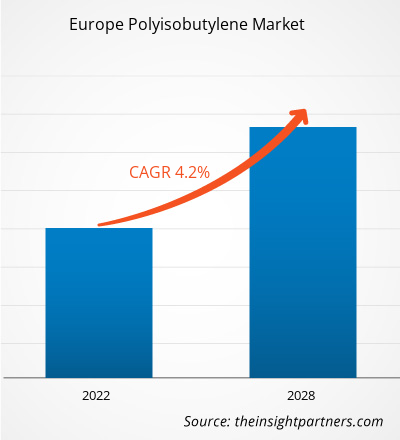The Europe polyisobutylene market is expected to reach US$ 1,118.9 million by 2028 from US$ 837.1 million in 2021. The market is estimated to grow at a CAGR of 4.2% from 2021–2028.
Urbanization is considered as just one of the international megatrends shaking up the construction industry. The population of the Europe urban zones is raising by 200,000 people per day, all of whom need reasonably priced housing as well as transportation, social and utility infrastructure. In such challenges, the construction industry is practically under a moral compulsion to transform. Its transformation is impacting elsewhere on the wider society, by reducing construction costs and by enlightening the use of scarce materials or by making buildings more eco-efficient and boosting economic development and by narrowing the Europe infrastructure gap. Utilization of polyisobutylene in owing to demand for material with high melt flow rates, greater elongation, as well as enhanced impact strength. Increasing infrastructure demand in the evolving economies on account of developing road infrastructure, increase in per capita ownership of houses and rising spending capacity is expected to affect the construction sector in the region, which in turn will drive the demand for polyisobutylene in Europe.
In Europe, Italy and Spain is the hardest-hit country by the COVID-19 outbreak. It is expected to suffer an economic hit due to a lack of revenue from various industries, as Italy recorded the highest number of coronavirus cases. Other member states have implemented drastic measures and travel restrictions, including partially closing their borders. This is anticipated to negatively impact market growth in Europe.
With the new features and technologies, vendors can attract new customers and expand their footprints in emerging markets. This factor is likely to drive the polyisobutylene market. The Europe polyisobutylene market is expected to grow at a good CAGR during the forecast period.
Europe Polyisobutylene Market Revenue and Forecast to 2028 (US$ Million)
Europe Polyisobutylene Market Segmentation
By Molecular Weight
- Low
- Medium
- High
By Product
- Conventional PIB
- Highly Reactive PIB
By Application
- Tires
- Industrial Lubes and Lube Additives
- Fuel Additives
- Adhesives and Sealants
- Other Application
By End User
- Industrial
- Food
- Others
By Country
- Europe
- Germany
- France
- UK
- Italy
- Russia
- Rest of Europe
Companies Mentioned
- BASF SE
- Braskem S.A.
- Daelim Industrial Petrochemical Division
- Ineos AG
- Infineum International Limited
- The Lubrizol Corporation
- TPC Group
- Kemat Polybutenes
- Kothari Petrochemicals
- Sibur Holding PJSC
Europe Polyisobutylene Report Scope
| Report Attribute | Details |
|---|---|
| Market size in 2021 | US$ 837.1 Million |
| Market Size by 2028 | US$ 1,118.9 Million |
| Global CAGR (2021 - 2028) | 4.2% |
| Historical Data | 2019-2020 |
| Forecast period | 2022-2028 |
| Segments Covered |
By Molecular Weight
|
| Regions and Countries Covered | Europe
|
| Market leaders and key company profiles |
- Historical Analysis (2 Years), Base Year, Forecast (7 Years) with CAGR
- PEST and SWOT Analysis
- Market Size Value / Volume - Global, Regional, Country
- Industry and Competitive Landscape
- Excel Dataset



Report Coverage
Revenue forecast, Company Analysis, Industry landscape, Growth factors, and Trends

Segment Covered
Molecular Weight, Product, Application, and End Use

Regional Scope
North America, Europe, Asia Pacific, Middle East & Africa, South & Central America

Country Scope
UK, Germany, France, Italy, Russia
Trends and growth analysis reports related to Chemicals and Materials : READ MORE..
- BASF SE
- Braskem S.A.
- Daelim Industrial Petrochemical Division
- Ineos AG
- Infineum International Limited
- The Lubrizol Corporation
- TPC Group
- Kemat Polybutenes
- Kothari Petrochemicals
- Sibur Holding PJSC

 Get Free Sample For
Get Free Sample For